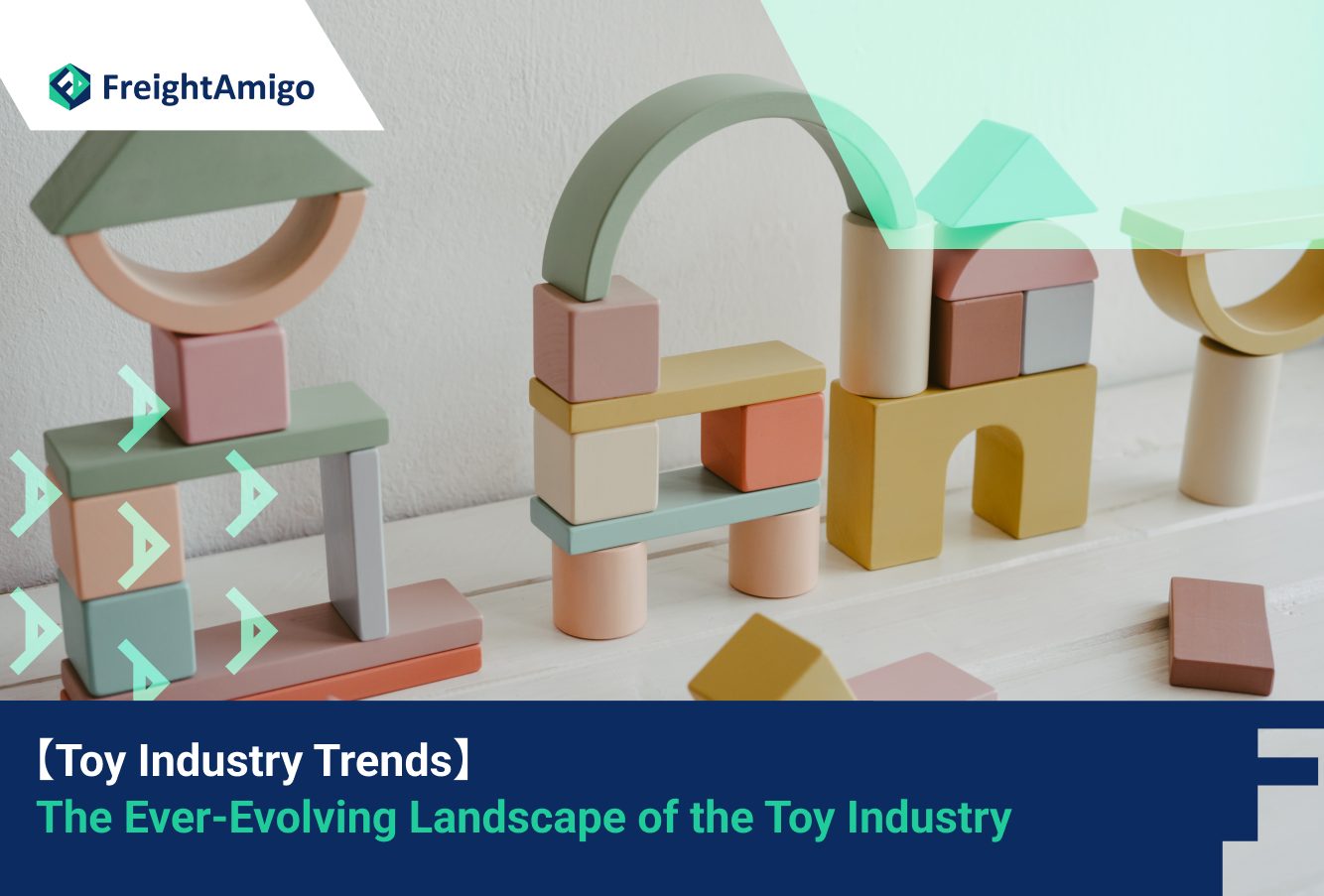The toy industry has always been a source of joy, imagination, and nostalgia for both children and adults. However, it is not immune to the winds of economic change. Over the years, the toy industry has experienced significant transformations driven by shifting consumer preferences, technological advancements, and global economic factors. In this comprehensive analysis, we will explore the recent economics of the toy industry, examining the key trends and challenges that have shaped its landscape.
Author Name: Jacob Leong – Marketing Analyst at FreightAmigo
Want to compare the best Express, Air Freight, Sea Freight, Rail Freight & Trucking rates so as to have better control on cost?
Changing Consumer Preferences: Embracing Digital Integration
One of the most notable shifts in the toy industry is the changing preferences of consumers. While traditional toys and games still hold a special place in the hearts of many, there is a growing demand for toys that incorporate technology. Smart toys, augmented reality (AR) games, and interactive learning toys have gained popularity, reflecting a broader trend of digital integration in everyday life. Toy manufacturers have had to adapt by incorporating digital features into their products, blurring the lines between the physical and virtual worlds.
This shift towards digital integration has not only changed the way toys are designed and manufactured but also how they are marketed and sold. With the rise of e-commerce, online retailers have become a dominant force in the toy industry. Consumers now have the convenience of shopping for toys from the comfort of their homes, with a wider selection and competitive pricing. As a result, traditional brick-and-mortar toy stores have had to adapt or face closure. Toy manufacturers have had to establish a strong online presence and optimize their e-commerce strategies to remain competitive in this ever-evolving landscape.
Sustainability and Eco-Friendly Toys: Meeting Consumer Values
In recent years, there has been a growing emphasis on sustainability and eco-friendliness across industries, including toys. Consumers are increasingly conscious of the environmental impact of their purchases, leading to a rise in demand for eco-friendly and ethically sourced toys. Toy companies have responded by using sustainable materials, reducing packaging waste, and promoting recycling. This shift towards eco-consciousness not only aligns with consumer values but also opens up new marketing opportunities for toy manufacturers.
The demand for sustainable toys not only comes from consumers but also from parents and educators who recognize the value of toys that promote learning and skill development. Educational toys and those focused on science, technology, engineering, and mathematics (STEM) have seen a surge in demand. As societies place greater importance on preparing children for future careers, these toys have become a lucrative segment of the market, with parents willing to invest in products that offer both entertainment and educational benefits.
Supply Chain Disruptions: Navigating Challenges in a Globalized Market
The global toy industry, like many others, has been affected by supply chain disruptions. The COVID-19 pandemic exposed vulnerabilities in supply chains, leading to delays in production and distribution. These disruptions resulted in inventory shortages, increased transportation costs, and higher prices for some toys. Toy companies have had to navigate these challenges by diversifying their supply chain sources and reevaluating their logistics strategies.
The pandemic has also highlighted the importance of resilience and adaptability in the toy industry. Companies that were able to quickly pivot and adjust their operations were better equipped to weather the storm. This has led to a renewed focus on digitalization and automation in manufacturing and distribution processes. By leveraging technology, toy manufacturers can improve efficiency, reduce costs, and better respond to future disruptions.
Licensing and Intellectual Property: Tapping into Emotional Connections
The toy industry has witnessed a surge in licensing and intellectual property collaborations. Popular movie franchises, video games, and animated series have become valuable sources of inspiration for toy manufacturers. Licensing agreements have enabled toy companies to create products based on beloved characters and storylines, capitalizing on the emotional connection consumers have with these properties.
These licensing partnerships not only drive sales but also contribute to brand loyalty and recognition. By aligning with well-known and beloved intellectual properties, toy manufacturers can tap into existing fan bases and leverage the power of nostalgia. This trend has opened up opportunities for innovative marketing campaigns, cross-promotions, and collaborations between toy companies and entertainment studios.
E-commerce Dominance: The Rise of Online Retailers
The rise of e-commerce has had a profound impact on the toy industry. Online retailers have become a dominant force, offering consumers a convenient way to shop for toys from the comfort of their homes. The convenience of online shopping, coupled with a wider selection and competitive pricing, has driven traditional brick-and-mortar toy stores to adapt or close their doors. Toy manufacturers have had to establish a strong online presence and optimize their e-commerce strategies to remain competitive.
The COVID-19 pandemic further accelerated the shift towards online shopping, as lockdowns and social distancing measures limited in-person retail experiences. Consumers turned to online platforms to fulfill their toy-buying needs, leading to a surge in online toy sales. This trend is expected to continue even as the world recovers from the pandemic, as consumers have become accustomed to the convenience and variety offered by online retailers.
Educational and STEM Toys: Preparing Children for the Future
Parents and educators have increasingly recognized the value of toys that promote learning and skill development. Educational toys and those focused on science, technology, engineering, and mathematics (STEM) have seen a surge in demand. As societies place greater importance on preparing children for future careers, these toys have become a lucrative segment of the market, with parents willing to invest in products that offer both entertainment and educational benefits.
Educational and STEM toys not only provide children with valuable knowledge and skills but also foster creativity, critical thinking, and problem-solving abilities. These toys often incorporate interactive elements, such as coding games or building sets, that engage children in hands-on learning experiences. Toy manufacturers have embraced this trend by developing innovative products that combine entertainment and education, catering to the growing demand from parents and educators.
The Future of the Toy Industry: Embracing Innovation and Consumer Needs
The toy industry is far from static; it continues to evolve in response to changing consumer preferences, technological advancements, and economic challenges. The recent economics of the toy industry reflect a sector in flux, where adaptability and innovation are key to success. By embracing sustainability, capitalizing on e-commerce opportunities, and staying attuned to evolving consumer needs, toy manufacturers can thrive in this ever-changing landscape.
The future of the toy industry holds exciting possibilities, with advancements in technology opening up new avenues for creativity and play. Virtual reality (VR) and augmented reality (AR) have the potential to revolutionize the toy industry, providing immersive and interactive experiences for children. Additionally, advancements in robotics and AI can create new opportunities for interactive and customizable toys.
As the industry continues to reinvent itself, one thing remains certain: toys will continue to bring joy, laughter, and imagination to generations to come. Whether it’s through traditional play or innovative digital experiences, the toy industry will remain a vital part of childhood memories and development. Toy manufacturers that embrace technological advancements, prioritize sustainability, and adapt to changing consumer preferences will be well-positioned for success in the dynamic toy industry of the future.
There are different options for cargo transportation. If you want to choose the most convenient and suitable solution, it is best to have the full support of logistics experts! If you are planning to ship goods overseas, please go to the FreightAmigo page for inquiries.
===
Read More:
【A Comprehensive Guide】 Big Data and Machine Learning in Financial Technology for Logistics
【Real-Time Tracking and Tracing】 A Game Changer in the Logistics Industry
【Car Logistics】 Revolutionizing Inventory Management in the Automotive Industry
===If you have any inquiries on logistics/supply chain, feel free to contact FreightAmigo now:
Chat with us online OR
Phone : +852 28121686
WhatsApp: +852 27467829









































